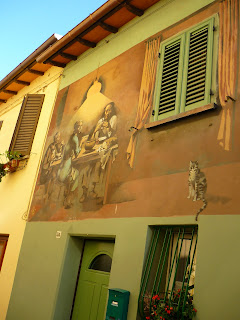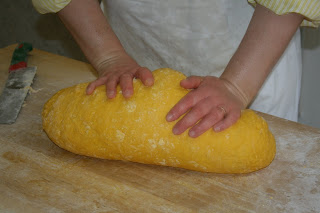
Vegetarian variation: with roasted red pepper and aubergine
This is a delicious easy to make meal but as always with simple dishes the details are crucial. So, do use a well flavoured chicken stock (I add some star anise to the carcass when I’m making it), and take care to lightly brown the onion and garlic before adding the rice.
You can make a vegetarian version by replacing the chicken and bacon with roasted red pepper and cubes of fried aubergine. Roast the pepper with the squash, then skin it and cut it into 3cm by 1 cm pieces. Cut the aubergine into 1cm cubes and fry in olive oil over a high heat. Add the aubergine to the risotto at the end of the cooking, then the red pepper. When you serve up ensure that the pepper and the aubergine are visible.
Ingredients for 4
600-700g butternut squash
1 large onion
2 cloves garlic
4 sage leaves
1 stick celery
2 skinned boneless chicken breasts or 4 thighs if you prefer
100g bacon or pancetta
50g parsley
40cl olive oil
Salt and ground pepper
50g butter
250g risotto rice (Arborio or similar)
600ml chicken stock
100ml white wine
50g parmesan grated
Method
1 large onion
2 cloves garlic
4 sage leaves
1 stick celery
2 skinned boneless chicken breasts or 4 thighs if you prefer
100g bacon or pancetta
50g parsley
40cl olive oil
Salt and ground pepper
50g butter
250g risotto rice (Arborio or similar)
600ml chicken stock
100ml white wine
50g parmesan grated
Method
1. Put the butternut squash into a medium hot oven to roast for 30 minutes.
2. Meanwhile, prepare the other ingredients: chop the onion and celery finely; chop the sage finely; cut the chicken into small pieces about 3cms by 1 cm; chop the bacon into small shards; chop the parsley finely.
3. Make a parsley oil by liquidising the puree with oil and seasoning it. Pour it into a squeezy bottle.
4. Remove the squash from the oven, allow to cool and then cut it open to remove the seeds and hairy innards. Then remove the skin. You will need 300 grams of puree.
5. Chop the squash flesh roughly, place in a saucepan with the butter, sage, and mash with a fork until it becomes a puree. Season to taste with salt and ground pepper.
6. Saute the chicken in the butter until it begins to brown.
7. Soften and lightly brown the onion, celery and garlic in the oil.
8. Place the bacon in a small oven proof container and then in a moderately hot oven for 15 minutes until it has become crunchy.
9. Add the butter and the rice to the onion and continue to fry for two minutes, stirring the rice so that it is amalgamated with the onion, celery and garlic.
10. Add the wine and cook off the alcohol.
11. Begin to add the heated stock to the rice, allowing it to absorb the liquid before adding more.
12. Put the squash puree on a moderate heat for ten minutes, stirring occasionally so that it doesn’t burn.
13. Now add the chicken to the rice, and continue to add the stock until the rice is cooked but retains a bite. Then add the half the cheese and stir it in.
14. Put a spoon of squash puree on each plate and shape it into a flat orange circle. Put a heaped spoon of the risotto on top and then a few shards of the bacon. Finally, using the squeezy bottle, create a neat parsley ring around the butternut squash and risotto.
15. Call ‘service’ or if you are short staffed put the plates on the table yourself. Pass the remaining cheese for guests to help themselves to.
























